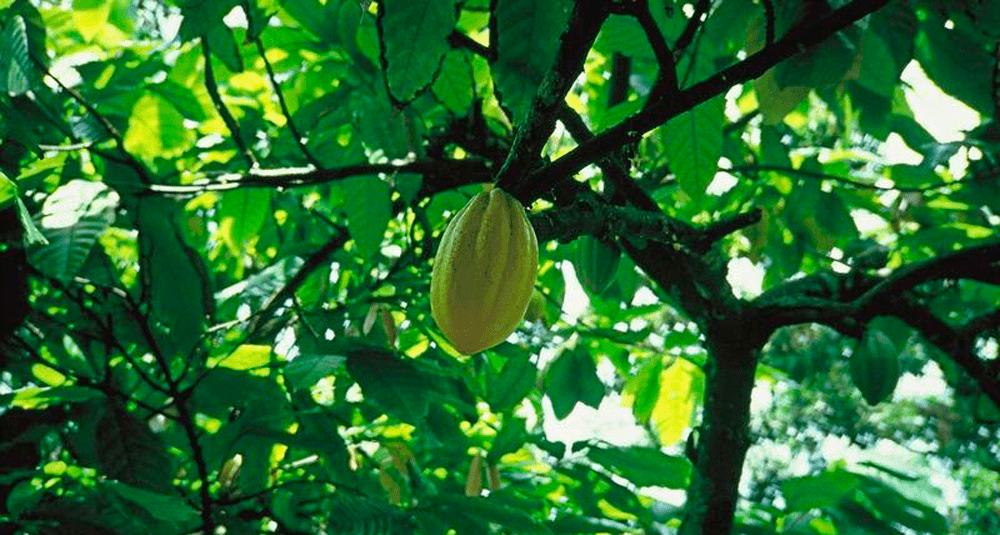What is the country of origin of the cocoa tree?
Last Updated:
The cacao tree, which produces the precious cacao beans used to make chocolate, is native to the tropical forests of South America, specifically the Amazon basin, a region that spans several countries, including Brazil, Peru, Bolivia, Ecuador, and Colombia. It was in these hot and humid regions that the wild cacao tree (Theobroma cacao) first appeared several thousand years ago.
The scientific name for the cacao tree, Theobroma cacao, comes from ancient Greek and literally means “food of the gods” (theos = god, broma = food). This name, given in the 18th century by the Swedish naturalist Carl von Linné, echoes the almost sacred importance that pre-Columbian peoples attached to this tree and its fruits.
The earliest evidence of cocoa use dates back around 3,500 years, in the pre-Columbian civilizations of Central and South America. Archaeological studies conducted in Honduras and Ecuador have revealed the presence of cocoa residues in pottery dating back to more than 1,000 years BCE. This shows that cocoa was already being consumed in liquid form long before the arrival of Europeans.
The Maya and Aztecs were among the first peoples to cultivate the cacao tree. Among the Maya, cacao played a central role in daily and religious life. They made it into a bitter, spicy drink called xocoatl, the ancestor of modern chocolate. This drink was reserved for the elite and the cé
The Mayans and Aztecs were among the first peoples to cultivate the cacao tree. Among the Mayans, cacao played a central role in daily and religious life. They made a bitter, spicy drink called xocoatl, the ancestor of modern chocolate. This drink, reserved for the elite and religious ceremonies, symbolized vitality and strength.
The Aztecs, meanwhile, imported cacao from regions further south, particularly from areas corresponding to present-day Guatemala. For them, too, cacao had divine value: they believed it came from the god Quetzalcóatl, the “feathered serpent,” who had given it to humanity. Cacao beans were even used as currency in their economy.
With the arrival of the Spanish conquistadors in the 16th century, the cacao tree was introduced to Europe. Hernán Cortés discovered the cacao drink during his encounters with the Aztecs and brought the beans back to Spain. Cacao quickly evolved from a bitter drink to a sweet one, thanks to the addition of sugar and vanilla. From the 17th century onwards, cocoa gained popularity in European royal courts, becoming a symbol of luxury and refinement.
Today, cacao trees are grown in many tropical regions between 20° north and south latitude, but their place of origin remains South America. Wild varieties of cacao come mainly from the upper Amazon basin, where the hot and humid climate provides ideal growing conditions.
There are three main varieties of cacao trees:
- Criollo, native to Venezuela and Central America, is renowned for its delicate aromas, but is fragile and not very productive.
- Forastero, native to the Amazon, is more robust and is now the most widely cultivated variety in the world (accounting for around 80% of global production).
- Trinitario, a hybrid of the first two varieties, appeared in Trinidad in the 18th century and combines the robustness of Forastero with the flavor of Criollo.
Although Ivory Coast, Ghana, and Indonesia are now the world’s largest producers, these countries are not the birthplace of the cacao tree. Their success is based on plantations imported from Latin America in the 19th century, when cacao cultivation became globalized.
The cacao tree is native to the Amazon basin in South America, where it grew naturally in tropical forests. From there, it conquered Central America and then the entire world. Its journey, from sacred plant of the Mayans to ingredient appreciated around the world, tells a story that is at once botanical, cultural, and historical, making cacao one of the most precious treasures on the planet.
nature

What is the country of origin of the cocoa tree?
Answer
The cacao tree, which produces cacao beans, is native to the tropical forests of South America, specifically the Amazon basin.